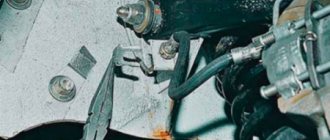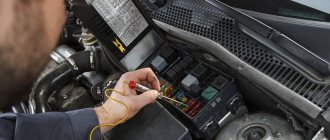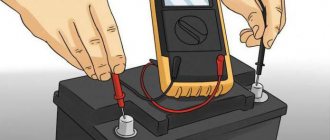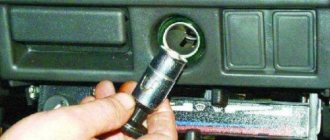The role of the battery in a modern car cannot be overestimated. With its help, the engine starts and it also powers numerous electrical appliances on board. Maintaining the battery in working condition is extremely important, and one of the techniques is to periodically check its capacity. Knowing how to measure amperes on a battery, you can calculate the moment when it will need charging.
Cigarette lighter amperage
A car cigarette lighter is a metal cup with contact plates into which a plug with an incandescent coil is inserted. The permissible current in the circuit is calculated depending on the resistance of the filament element and the voltage in the on-board network (according to Ohm's law). The cross-section of multi-core switching wires and the rating of the fuse, which is installed in the cabin unit (installed in the instrument panel or in the luggage compartment of the car), are selected accordingly.
Please note that the equipment is designed to operate at maximum power for 10-15 seconds. After heating the spiral, the bimetallic lock is activated, and the spring built into the plug automatically opens the contacts. The fuse rating is in the range from 10 to 15 A (depending on the manufacturer and model of the machine, information is indicated in the operating instructions).
In the event of a short circuit, the fuse jumper cannot withstand the increased current and is destroyed, breaking the circuit.
The machine owner must replace the insert with an element with identical operating parameters. The use of high-rated fuses or homemade devices (“bugs”) is strictly prohibited. If the insert fails again, it is necessary to diagnose the electrical circuit and eliminate the cause of the short circuit.
Is it possible to increase or decrease the indicators?
Car manufacturers strictly prohibit interfering with the design of standard electrical wiring. Installing fuses with a higher rating leads to overheating of electrical harnesses and destruction of insulators. In the event of a short circuit, the insert is not destroyed, which leads to heating of the metal cables and a fire in the instrument panel or engine compartment. Since the design of the car uses flammable materials, the slightest fire in the cabin leads to complete burnout of the car.
During operation of the machine, you should not install splitters for several devices in the standard cigarette lighter, which do not ensure the safety of the electrical circuit connection. If there is poor contact between the insert and the body, the metal contacts burn, impairing the conductivity of the metals. In this case, it is necessary to replace worn parts; traces of carbon deposits are removed with sandpaper.
If the owner of the car wants to connect equipment with increased power (for example, an electric pump for inflating tires), then it is necessary to install a separate outlet. The device is connected directly to the battery; a protective fuse is provided in the circuit. For connection, copper wire with an increased cross-section is used, capable of withstanding increased load. Switching through a relay is allowed, allowing the socket to be used only after the ignition is turned on (to protect the battery from discharge).
Principle of operation
A car cigarette lighter consists of several elements: a metal socket and a socket into which it is inserted. A constant minus is connected to the body, and a plus comes to the outer shell. When you press the button, the contacts close and the metal coil located inside the car cigarette lighter begins to heat up. When the maximum temperature is reached, the thermal relay is activated, which snaps the device into its original position.
Summarizing
Car enthusiasts should know that the battery discharges on its own. This happens if the car is not used for a long time. If you have a new battery installed and you have parked the car, then after 12 months it is not a fact that you will be able to start it. In old batteries this figure is even less - no more than a month.
Therefore, when storing a car for a long time, it is worth visiting it periodically and warming it up - at least once a month. This will not only preserve the battery, but also prevent the oil from emptying in the engine crankcase. After a deep discharge, charging the battery becomes difficult, and in some cases impossible, so if you decide to start the car after a long period of parking, then buy a fresh battery.
Source of the article: https://3batareiki.ru/akkumulyatory/avtomobilnye-akkumulyatory/kak-opredelit-skolko-amper-chasov-v-akb-avtomobilya-i-skolko-amper-nuzhno-dlya-zaryadki
What is the current strength in the cigarette lighter
- To the beginning of the forum
- Forum Rules
- Old design
- FAQ
- Search
- Users
- List of forums AUTOLADA.RU
- "Classic"
How about me? If possible about the cigarette lighter socket.
How quickly will it remain in your hand if you periodically pull it? And do you have to constantly uh... plug the hole after pulling out the plug or can you leave it like that?
go to the radio parts and say: there is a supply source with a voltage of 12-15 volts, but I need to get exactly 12 volts at the output. They will give you a small nasty thing with 4 legs and it will stabilize your tension.
this thing is inserted into the cigarette lighter
Install an additional stabilizer-crank before the cigarette lighter to a lower U=8v, the figure is powered from 5v.
Machanga
Of course, I do not rule out that China Town products “stall” at 14 volts, but this is unlikely... Read the instructions, there are technical data, and the range is written - at what voltage it all works, then measure the voltage of the on-board network, turn the gas , and measure the maximum speed (with other consumers turned off)..
Angel
Looks like you have the cheapest plug... Change it anyway. Well, or suffer - this one, which is cheap, can only be inserted at a certain angle into the socket. Let me explain? look into the socket, there will be cutouts on the “body”, and the plug’s “negative” tendrils are too narrow - if they get into those cutouts and you pull towards yourself, the plug may fall apart.. Not the socket, but the plug - the socket must be screwed on with a nut - you can’t tear it off.
Although. There on Emelya, it seems, there is not a plug at all, but a stray device with a regulator, and the “cons” are wide.
lomond
Well, you bent! Of course, if a device is made to work from 10.14 volts, then it is not required to work from 8, no matter what is inside..
Well, you bent! Of course, if a device is made to work from 10.14 volts, then it is not required to work from 8, no matter what is inside..
Anhel It looks like you have the cheapest plug.. Change it for the hell of it. Well, or suffer - this one, which is cheap, can only be inserted at a certain angle into the socket. Let me explain? look into the socket, there will be cutouts on the “body”, and the plug’s “negative” tendrils are too narrow - if they get into those cutouts and you pull towards yourself, the plug may fall apart.. Not the socket, but the plug - the socket must be screwed on with a nut - you can’t tear it off.
Vehicle electrical loads
Electric generator loads can be divided into three separate groups:
- permanent
- long-term
- short-term
The charging system of a modern vehicle must cope with high demands under many different conditions. To get some idea of the power required, add up the power consumed by each individual vehicle component and add that sum to the power required to charge the battery. The table provides a list of typical electrical power requirements for various vehicle systems. For comparison, current consumption is given (to the nearest 0.5 A) at 14 and 28 V (alternator output voltage ratings for 12 V and 24 V systems).
Rice. Alternator Requirements
Some items missing from the list include preheated catalytic converters, electric power steering and heated windshields. This list will expand, and the charging system will have to meet all new needs.
Table. Typical power consumption of vehicle electrical components
| Constant loads | Power, W | Current at 14 V, A | Current at 28 V, A |
| Ignition | 30 | 2 | 1 |
| Fuel injectors | 70 | 5 | 2,5 |
| Fuel pump | 70 | 5 | 2,5 |
| Dashboard | 10 | 1 | 0,5 |
| Total | 180 | 13 | 6,5 |
| Continuous loads | Power, W | Current at 14 V, A | Current at 28 V, A |
| Side and tail lights | 30 | 2 | 1 |
| Room lighting lights | 10 | 1 | 0,5 |
| Driving lights | 200 | 15 | 7 |
| Low beam headlights | 160 | 12 | 6 |
| Instrument lights | 25 | 2 | 1 |
| Receiver/Tape/CD | 15/30 | 1,0/2,0 | 0,5/1,0 |
| Total (at average headlight load) | 260-270 | 20 | 10 |
| Short-term loads | Power, W | Current at 14 V, A | Current at 28 V, A |
| Heater | 50 | 3,5 | 2 |
| Indicators | 50 | 3,5 | 2 |
| Brake lights | 40 | 3 | 1,5 |
| Front wipers | 80 | 6 | 3 |
| Rear wipers | 50 | 3,5 | 2 |
| Power windows | 150 | 11 | 5,5 |
| Radiator cooling fan | 150 | 11 | 5,5 |
| Interior heating fan | 80 | 6 | 3 |
| Rear window defroster | 120 | 9 | 4,5 |
| Indoor lamps | 10 | 1 | 0,5 |
| Sound signals | 40 | 3 | 1,5 |
| Rear fog lights | 40 | 3 | 1,5 |
| Reversing lights | 40 | 3 | 1,5 |
| Additional lamps | 110 | 8 | 4 |
| Cigarette lighter | 100 | 7 | 3,5 |
| Headlight cleaner | 100 | 7 | 3,5 |
| Seat adjustment | 150 | 11 | 5,5 |
| Heated seat | 200 | 14 | 7 |
| Sunroof drive motor | 150 | 11 | 5,5 |
| Electric mirror drives | 10 | 1 | 0,5 |
| Total | 1.7 kW | 125,5 | 63,5 |
Short-term loads occur infrequently, and some energy consumers, such as heated rear windows and seat heaters, are usually equipped with a timer relay. Therefore, to simplify further calculations, a coefficient of 0.1 is applied to the total amount of required power. The vehicle is expected to use this amount of power under normal driving conditions.
The consumer requirement for an alternating current generator is the sum of constant loads, long-term loads and short-term loads (with an applied coefficient). In this example:
180 + 260 + 170 = 610 W (43 A at 14 V).
Consequently, the demands placed on the charging system are quite significant. This load is in addition to the current required to recharge the battery.
Source of the article: https://ustroistvo-avtomobilya.ru/akkumulyator-generator-starter/elektricheskie-nagruzki-avtomobilya/
Connection diagram
A standard car cigarette lighter has three wires.
- A constant plus, responsible for heating the element. Connected to the battery through a fuse of a certain rating. Typically the red wire.
- The cable responsible for the operation of the car cigarette lighter light bulb. Permanent plus yellow or green.
- Mass, constant minus. A black wire, one end connected to the body of the device, and the other to the body of the car.
Terms of use
To extend the life of your car cigarette lighter, you should follow several recommendations.
- Install fuses designed for the amperage specified by the manufacturer. Failure to comply with this rule may result in a short circuit and may cause a fire.
- Do not connect several powerful devices through a splitter or tee at the same time (for example, a pump and a vacuum cleaner).
- Periodically clean the contacts using a file, getting rid of oxides or rust.
- When connecting foreign devices, periodically check the temperature of the adapter with your hand to monitor its operation.
How should you charge a car battery?
There are two ways to charge the battery. The first of them is relevant if the battery is working and the car can start. To charge you do not need to remove the battery, just drive the engine at high speeds for 10-15 minutes. The main thing is to follow two rules:
- Do not do this in a closed space (for example, a garage or repair bay), otherwise you will suffocate from exhaust gases;
- Do not turn on lighting fixtures.
After all these steps, the battery will gain sufficient charge and will gradually recover if you operate the car for at least several hours in a row. It is advisable to do this during the daytime so as not to create an increased load on the battery with the headlights and interior lighting on.
For the second method, you will need a charger. You need to proceed in the following order:
- Remove the battery from the engine compartment and place it on a flat surface.
- Unscrew the battery caps to allow gas to flow out during charging.
- Cover the holes (loosely) to prevent acid from splashing onto the top of the battery. To do this, you can simply turn the plugs over with the threads facing up and place them in the grooves of the holes.
- Connect the charger to the battery - plus to plus, minus to minus.
- Connect the battery to the network and set the input current equal to 1/10 of the battery capacity (for example, with a volume of 55 A/h, you need to set the indicator to 5.5 Amperes).
- Leave the battery alone until active gas formation begins in all cells. On average, a full charge takes 8-10 hours, but this figure is relative and varies depending on the degree of battery wear, temperature, and other things.
- After disconnecting, do not immediately tighten the plugs; wait at least 20 minutes for the remaining gas to evaporate from the battery capacity.
- Then tighten the plugs and install the battery in the car.
To understand how many amperes there should be when charging a battery, you need to know exactly the battery capacity. Otherwise, charging may be too slow (if you set the value below the required value), or, on the contrary, the batteries will be overcharged, which will negatively affect its resource.
It is also worth being able to determine the state of charge of the battery. This can be done using a multimeter. A car battery provides 100% charge at the terminals of 12.6-12.7 Volts. If the indicator decreases to 12.5, then this means that the charge has dropped by 10-15%. In a regularly driven car, the current power generated by the battery is on average 12.2-12.3 Volts, and this is normal, since the battery in a car is never 100% charged except for those moments when it is removed for recharging or replacement.
Device
The photo below shows a drawing of a car cigarette lighter:
- Central contact.
- Ceramic insulator.
- Return spring.
- Car cigarette lighter socket.
- Removable element.
- Power button.
- Thermal insulation.
- Metal body.
- Nichrome plate.
- Bimetallic clamps.
Cigarette lighter socket
Today, the device is practically not used for its original purpose - lighting cigarettes. The cigarette lighter socket is now regarded as a standard 12-volt outlet for connecting electrical accessories. Among the most common devices connected to a car cigarette lighter:
- electric compressor for inflating wheels;
- GPS navigator for route calculation;
- DVR;
- car vacuum cleaner;
- chargers for phone, tablet, laptop.
Cigarette lighter modification
Some drivers upgrade the device by installing an additional connector. To do this you will need to acquire a tool.
- Drill or screwdriver with a set of metal drills.
- A crown for cutting a hole, the diameter should match the diameter of the car cigarette lighter.
- File.
- Soldering iron with solder.
- Wire cutters.
- Screwdrivers.
- Multitester.
- Heat-shrink tubing.
- Wire of suitable cross-section. You should take extra cables to avoid the possibility of melting. The optimal cross-section would be 1.5-2 mm.
- A fuse that can withstand the amperage recommended by the vehicle cigarette lighter manufacturer.
Next, we proceed to installing the additional device ourselves.
- We turn off the power to the car and select a place to connect an additional car cigarette lighter. It is advisable that it be a flat panel - the device will not stick to corrugated or curved surfaces.
- We drill a hole of a suitable diameter and clean the edges with a file.
- We connect to the wiring by following the pinout and passing through the fuse.
- We check the functionality of the model and carry out assembly.
Before work, you need to buy suitable spare parts. It is advisable to purchase original parts. The price of a cigarette lighter ranges from 300 to 1500 rubles.
Permissible leakage current
Once you have calculated the consumption at rest, you can use the table to determine the permissible leakage current values based on the table. Where it is marked at what level of losses you can start the car.
| Leakage current to consumers (mA) | How long will it take for the car to not start? |
| ≤20-30 | The car will be able to sit in the parking lot for a couple of weeks without moving and then start up without any problems. |
| 50-80 | A bit much if there is a standard alarm system, but tolerable when there is a developed non-standard audio system. A car with an old battery may no longer start after literally 3-4 days. |
| ≥100> | A sign of electrical equipment malfunction or installation of low-quality gadgets. In winter, it will be enough not to start the car for 1-2 days, and you will already need to light a cigarette. |
Knowing the leakage current in the car, you can calculate how long the battery will last (discharge time) if the car is parked for a long time at rest.
Car heater
During the cold season, you can connect a special device to the car cigarette lighter. It is a kind of 12-volt hair dryer. Inside it there is a thin spiral, which is heated by the circuit, and air passes through it.
There are various devices - some help warm up the car interior in winter, while others have an additional cord and are portable. With their help you can heat problem areas (rear window). There are special seat pads with heating elements. The power of such devices fluctuates around 200 watts.
Battery types
There are 2 types of batteries: acid, which use sulfuric acid as an electrolyte, and alkaline (the electrolyte is an alkaline solution). Alkaline ones react sensitively to low temperatures, so they are rarely used in cars.
- Antimony – the plates contain a lot of antimony (>5%). Outdated technology, such batteries are no longer produced. They have a long service life and can withstand a large number of charges and discharges;
- Low antimony - an analogue of the previous one only with a reduced antimony content and higher quality technical characteristics;
- Calcium - contain calcium instead of antimony, sometimes with a small admixture of silver. They have more stable characteristics, but are very sensitive to deep discharge;
- AGM or Gel batteries - a new technology, the electrolyte is in a bound state in the form of a gel. They have a high cost (for comparison, if a good calcium battery can be purchased for 3-5 thousand rubles, then for a similar gel battery the price starts from 10 thousand.) They have high quality characteristics, but require special charging equipment, since they are charged at lower current values.
- Nickel - contain nickel associated with cadmium (Ni─Cd) or metal hydroxide (Ni-Mh) have good quality characteristics, but are not used in cars due to their large dimensions (the specific current of alkaline batteries is less than that of acid batteries, therefore more cells are needed). They are used in electric forklifts and are sometimes installed on trucks.
- Lithium (Lithium-ion) - cheap to produce, but sensitive to low temperatures. The main consumption segment is electronics. Starter batteries for cars with internal combustion engines are not produced using this technology. Often used in electric vehicles.
USB socket
Drivers often install an additional connector instead of the cigarette lighter. A USB socket allows you to connect various electronic gadgets such as:
- navigator;
- mobile phone;
- tablet;
- TV;
- vacuum cleaner.
There are several variations of adapters from the car cigarette lighter to a USB socket.
- Compact when the adapter is inserted into the socket.
- Portable - with additional wire. This allows you to reach anywhere in the cabin.











